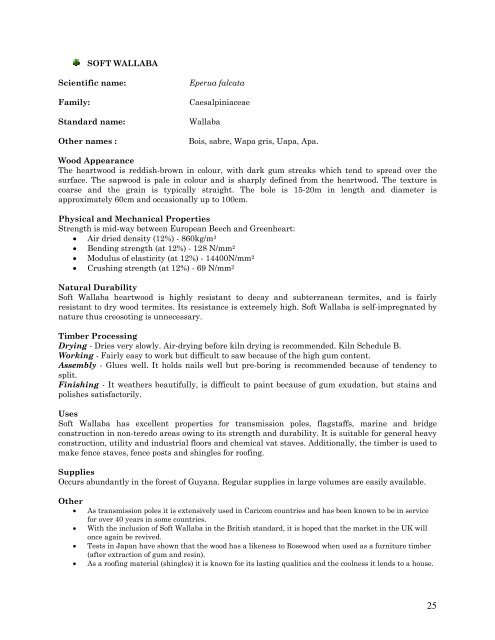21 Species Booklet 2004.pdf - Guyana Forestry Commission
21 Species Booklet 2004.pdf - Guyana Forestry Commission
21 Species Booklet 2004.pdf - Guyana Forestry Commission
Create successful ePaper yourself
Turn your PDF publications into a flip-book with our unique Google optimized e-Paper software.
SOFT WALLABA<br />
Scientific name: Eperua falcata<br />
Family: Caesalpiniaceae<br />
Standard name: Wallaba<br />
Other names : Bois, sabre, Wapa gris, Uapa, Apa.<br />
Wood Appearance<br />
The heartwood is reddish-brown in colour, with dark gum streaks which tend to spread over the<br />
surface. The sapwood is pale in colour and is sharply defined from the heartwood. The texture is<br />
coarse and the grain is typically straight. The bole is 15-20m in length and diameter is<br />
approximately 60cm and occasionally up to 100cm.<br />
Physical and Mechanical Properties<br />
Strength is mid-way between European Beech and Greenheart:<br />
• Air dried density (12%) - 860kg/m 3<br />
• Bending strength (at 12%) - 128 N/mm 2<br />
• Modulus of elasticity (at 12%) - 14400N/mm 2<br />
• Crushing strength (at 12%) - 69 N/mm 2<br />
Natural Durability<br />
Soft Wallaba heartwood is highly resistant to decay and subterranean termites, and is fairly<br />
resistant to dry wood termites. Its resistance is extremely high. Soft Wallaba is self-impregnated by<br />
nature thus creosoting is unnecessary.<br />
Timber Processing<br />
Drying - Dries very slowly. Air-drying before kiln drying is recommended. Kiln Schedule B.<br />
Working - Fairly easy to work but difficult to saw because of the high gum content.<br />
Assembly - Glues well. It holds nails well but pre-boring is recommended because of tendency to<br />
split.<br />
Finishing - It weathers beautifully, is difficult to paint because of gum exudation, but stains and<br />
polishes satisfactorily.<br />
Uses<br />
Soft Wallaba has excellent properties for transmission poles, flagstaffs, marine and bridge<br />
construction in non-teredo areas owing to its strength and durability. It is suitable for general heavy<br />
construction, utility and industrial floors and chemical vat staves. Additionally, the timber is used to<br />
make fence staves, fence posts and shingles for roofing.<br />
Supplies<br />
Occurs abundantly in the forest of <strong>Guyana</strong>. Regular supplies in large volumes are easily available.<br />
Other<br />
• As transmission poles it is extensively used in Caricom countries and has been known to be in service<br />
for over 40 years in some countries.<br />
• With the inclusion of Soft Wallaba in the British standard, it is hoped that the market in the UK will<br />
once again be revived.<br />
• Tests in Japan have shown that the wood has a likeness to Rosewood when used as a furniture timber<br />
(after extraction of gum and resin).<br />
• As a roofing material (shingles) it is known for its lasting qualities and the coolness it lends to a house.<br />
25


